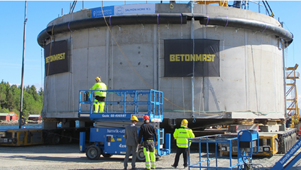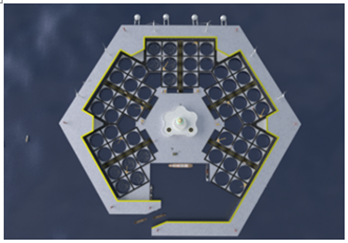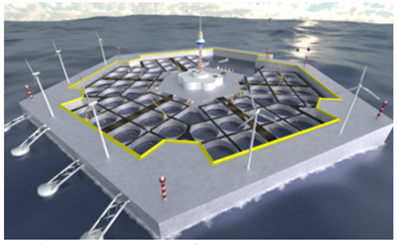
Moving offshore for fish farming
CM Wang,
Regret for the inconvenience: we are taking measures to prevent fraudulent form submissions by extractors and page crawlers. Please type the correct Captcha word to see email ID.

YI Chu, JC Park
CM Wang, School of Civil Engineering, The University of Queensland, St Lucia, Queensland 4072, Australia
Correspondence:
Received: January 31, 2019 | Published: March 5, 2019
Citation: Wang CM, Chu YI, Park JC. Moving offshore for fish farming. J Aquac Mar Biol. 2019;8(2):38-39. DOI: 10.15406/jamb.2019.08.00240
Download PDF
Opinion
Fish farm operators worldwide are moving their farms offshore due to lack of available nearshore production sites in heavily contested coastal zone, where there is increasing conflict with other usages such as shipping, fishing, tourism, conservation and recreation. Moreover, offshore sites provide much larger sea space and better water quality that are needed to increase the production of healthy fishes. As to what constitutes an offshore fish farming site, the authors opine that the offshore site has the following characteristics (i) unsheltered waters defined by the seaspace outside a straight line joining two major capes/promontories or within 25 nautical miles from the shoreline for economic feasibility1 (ii) water depth greater than 3 times the cage height and at least 15m between the cage bottom and the seabed for better dispersion of fish wastes2 and (iii) current speed3 ranging from 0.5m/s to 1m/s. However, going offshore poses many challenges due to the high energy environment, inaccessibility of power supply and supporting services.
Based on a literature review on offshore fish farming, we identify the following 4 possible solutions for offshore cage designs:
- Using more rigid and robust cages to withstand the high energy environment. Examples are (i) Havfarm: 430m in length and 54m wide that has the capacity to produce 10,000 tons of salmon or over 2 million fish; (ii) Pisbarca: Hexagonal steel structure with 7 cages having a total volume of 10,000m3 and (iii) Ocean Farm 1: Diameter of 110m and volume of 250,000m3 that can accommodate 1.5 million salmons – see Figure 1.
- Using submerged cages so as to move away from the strong surface waves. Examples are (i) Farmocean: Developed in Sweden and launched in 1986, volume ranging from 2500 to 6000 m3; Sadco: A ballasted upper steel hexagonal structure with a lower sinker tube to keep the net in shape. Volumes are available up to 2000m3 ; (iii) AquaPod: Developed by Ocean Farm Technologies (USA), features two-point anchor for mooring with net cleaner and remover of dead fishes.
- Designing closed containment tanks on large floating platforms, big barges or ships for a controlled environment. Examples are (i) Neptun: Containment tank having an internal diameter of 40m and a gross volume of 21,000m3; (ii) Dr. Techn. Olav Olsen tank: Cylindrical concrete tank with a 14.8m inner diameter – see Figure 2; (iii) Eco-Ark: AME2 Pte Ltd developed a closed containment, water flow-through floating fish farm equipped with solar panel for electricity supply

Figure 2 Olav Olsen Tank(photo courtesy of Tor Ole Olsen).
- Creation of a sheltered sea space for fish pens by using floating breakwaters at the offshore site. An example is the authors’ HEXAGON as shown in Figures 3A & 3B. Box shaped concrete breakwaters are used to enclose 415,000m2 sea space of a hexagonal shape. The breakwaters serve as platforms to carry offshore renewable energy converters for power supply to the farm. Also their internal spaces are used for feed storage, and to house desalination plant, waste water treatment plant and hydrogen production plant. In the middle of the sheltered sea space is a hexagonal floating concrete platform that carries the necessary facilities for a stand-alone fish farm such as control tower, admin offices, fish and fish food processing facilities, warehouses, workers quarters, pump room, power plant, and berthing facility. The central floating platform is surrounded by modular floating platforms with flexible connectors to dissipate wave energy. The modular floating platforms have 50 circular cutouts of diameter 50m for fish pens that can accommodate a total of 6.5 million fish (130,000 fish for each pen) and carries roadways for vehicles and cranes to access the fish pens.

Figure 3(A) Plan view of HEXAGON.

Figure 3(B) Isometric view of HEXAGON.
It is clear that moving offshore for fish farming is expensive. However, it is expected that the costs for offshore farming will be reduced significantly in future by using advanced technologies in offshore engineering and materials, co-locating with offshore renewable energy systems for power supply and deploying remote technologies and drones.
Acknowledgments
The authors are grateful to the Australian Research Council for providing the Discovery Project DP190102983 grant to perform the study on next generation offshore blue water aquaculture.
Conflicts of interest
Author do not have any conflicts of interest.
References
- Kapetsky J, Aguilar-Manjarrez J, Jenness J. A global assessment of offshore mariculture potential from a spatial perspective. FAO Fisheries and Aquaculture Technical Paper No. 549, Rome, 2013.
- Cardia F, Lovatelli A. Aquaculture operations in floating HDPE cages: a field handbook. FAO Aquaculture Newsletter. 2016;54:51.
- Turner R. Offshore mariculture: site evaluation. In: Mediterranean Offshore Mariculture by JF Muir, B Basurco. Options Mediterraneennes, Series B, No. 30, CIHEAM, Zaragoza. 2000;141–157.

©2019 Wang, et al. This is an open access article distributed under the terms of the,
which
permits unrestricted use, distribution, and build upon your work non-commercially.


